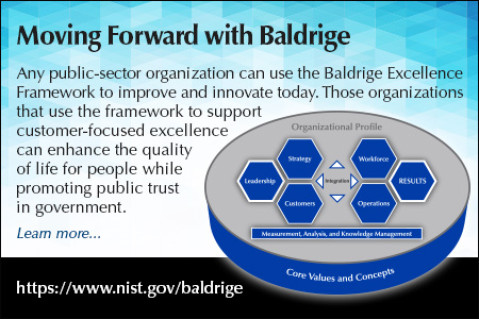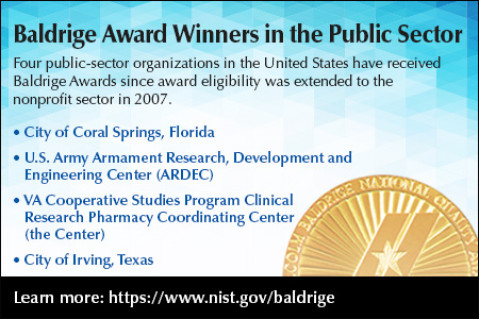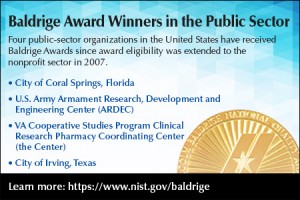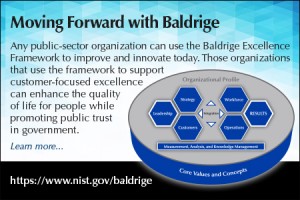Widgetized Section
Go to Admin » Appearance » Widgets » and move Gabfire Widget: Social into that MastheadOverlay zone
Improving Government Performance: The Great Promise of the Baldrige Excellence Framework
The views expressed are those of the author and do not necessarily reflect the views of ASPA as an organization.
By Christine Schaefer
October 21, 2016
When you hear the word Baldrige, what comes to mind?
- A prestigious national award launched in the 1980s to advance U.S. manufacturers’ global competitiveness
- A brilliant, unorthodox U.S. secretary of commerce during Ronald Reagan’s presidential administration
- A misspelled word (shouldn’t it be Baldridge?)
If you chose one of the first two answers above, you already know two things about one of the most unique—and evolving—programs in the federal government. Changes in the Baldrige Performance Excellence Program (BPEP) over the past decade have given it the capacity to offer U.S. government organizations a promising and proven means of improving performance and achieving customer-focused excellence.
Basic Facts about the Baldrige Program
Housed within the U.S. Department of Commerce’s National Institute of Standards and Technology (NIST), BPEP manages the nation’s only presidential award for organizational excellence. The Baldrige Award honors U.S. businesses as well as nonprofit, health care, and education organizations that demonstrate excellent performance in seven key areas:
- Leadership
- Strategy
- Customers
- Knowledge management and performance measurement
- Workforce
- Operations
- Results
The 29-year-old program was named after the late U.S. commerce secretary Malcolm Baldrige. Supported by a unique public-private partnership that includes a nonprofit foundation, the federal program annually trains a large volunteer corps (500-plus in some years) of competitively selected experts in multiple professional fields and sectors throughout the country. Called Baldrige examiners, these volunteers conduct assessments and provide feedback to Baldrige Award applicants to help them improve their performance. Other volunteer experts serve on the Baldrige Program’s panel of judges, reviewing finalists for the annual award in order to help the U.S. secretary of commerce select the recipients.
Today, BPEP continues to offer as its key resource the Baldrige Excellence Framework, which includes the Criteria for Performance Excellence and has set the worldwide standard for organizational excellence. The Baldrige framework booklets, available in three sector-specific versions, include a comprehensive and regularly revised set of assessment criteria that enable organizations to assess and improve processes and results using a systems perspective. Adopting this leadership and management framework and using the assessment criteria have helped thousands of U.S. organizations of wide-ranging sectors and sizes improve their performance and support their long-term success.
How Baldrige Grew to Support Nonprofits
The following events enabled the Baldrige Program to more fully support excellence in public-sector organizations:
- In 2004, congressional legislation authorized the Baldrige Program to expand award eligibility to nonprofit organizations beyond education and health care, including government agencies and subunits.
- In 2006, NIST’s fiscal year appropriation provided the Baldrige Program with additional funding to move forward with the expansion to fully serve the nonprofit sector. That work included revising the business version of the Criteria for Performance Excellence to make the requirements fully relevant to nonprofit organizations and running a pilot award process in which Baldrige examiners assessed a nonprofit organization.
- Beginning in 2007, all nonprofit organizations, including those in the public sector, could apply for the Baldrige Award. (Note: Nonprofit health care and education organizations had been eligible to apply since 1999.)
- From 2007 through 2016, 82 nonprofit organizations have applied for the Baldrige Award, and seven nonprofits have received it, including two municipal governments and two federal units that are part of U.S. military and veterans organizations. (Note: For the 2016 award cycle, recipients will be named in November.)
Value to the Public Sector
Why do government organizations choose to embark on a journey of improvement using the Baldrige framework? Consider the response of Michael Levinson, former city manager of Coral Springs, Florida, who led the city when it became one of the first government organizations to earn a Baldrige Award:
“People ask, ‘Why Baldrige?’ My answer is very simple: triple-A bond rating on Wall Street from all three rating agencies, bringing capital projects in on time and within budget, a 96 percent business satisfaction rating, a 94 percent resident satisfaction rating, an overall quality rating of 95 percent, and an employee satisfaction rating of 97 percent . . . that’s why we’re involved with Baldrige.”
Similarly, Dr. Joseph A. Lannon, director of the first federal Baldrige Award recipient, U.S. Army Armament Research, Development and Engineering Center (ARDEC), said his organization adopted the Baldrige criteria “in order to become the best organization we can possibly be and provide the best products and support we can to the U.S. warfighter.”
The framework is scalable for use by organizations of any size. Whether one is a small government department or a large agency, an organization can use the resource as a basis for improving the effectiveness and efficiency of its operations as well as develop systematic and innovative processes to strengthen leadership, strategic planning, customers, knowledge management and performance measurement, and workforce engagement.
Municipal and state government organizations in states such as California, Florida, Kansas, Tennessee, and Texas have been discovering these benefits over the past decade. Many have received awards from their regional or state-level Baldrige-based programs, and some may eventually apply for the Baldrige Award to receive more feedback on their performance and gain the opportunity to earn national recognition for their achievements.
In the meantime, the four government organizations that have earned the Baldrige Award between 2007 and 2015 provide role models for others in the public sector that wish to perform at the highest levels possible to serve residents in every U.S. community.
Author: Christine Schaefer has been a staff member of the Baldrige Performance Excellence Program since 2005. A writer-editor, she has served as a team leader for the past three years, supporting the management of publications, communications, award process and other assessment activities, and training. She has a bachelor’s degree from the University of Virginia in political and social thought and a master’s degree from Georgetown University, where her coursework and thesis focused on social and public policy issues.








 (7 votes, average: 4.71 out of 5)
(7 votes, average: 4.71 out of 5)
Pingback: Improving Government: Five Stories from Four States | PA TIMES Online